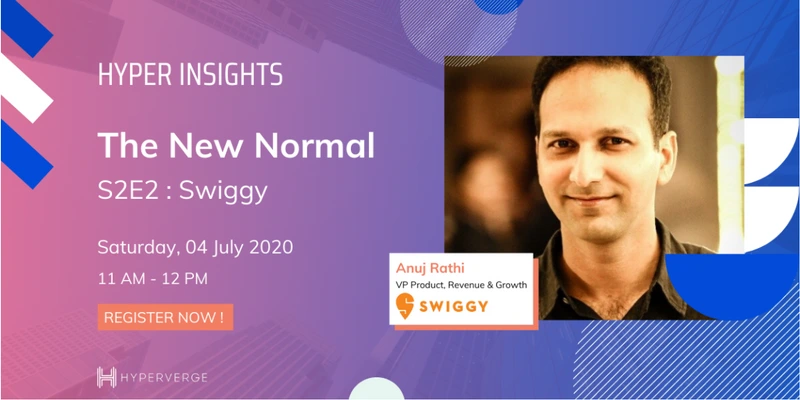Swiggy was in 7 cities for the first 4 years of its operations. 6 years since then it has expanded to over 500 cities. Here’s how.
Introduction
The year is 2015. Swiggy was just another startup that had raised money among a plethora of ‘food-tech’ startups. Six years hence, Swiggy is among the chosen few that remain standing. Swiggy has not just survived, it is now a household name in most Indian cities. The journey to becoming one of India’s most coveted startups has been one of customer obsession, foreseeing opportunities, and placing counterintuitive bets. Anuj Rathi, VP Product, Growth, and Revenue has been at the centre of this journey to the top of consumer minds.
On the second episode of HyperInsights Season 2 Anuj helps shed some light on the journey of going from a million orders a month to a million orders a day in 3 years. The summary of the conversation is given below.
Adopting and executing from a growth mindset (link)
Context
Under normal circumstances, the word “growth” has very straightforward connotations of achieving user traction, network effects, and so forth. However, these are not normal circumstances. Old play-books no longer apply. Especially for Swiggy as there’s a contagious virus out there and there are lockdowns and Swiggy delivers food. Anuj tells us about how one can learn to not only adapt but thrive in these times.
HyperInsights
- Reassess what has changed for your customer. Re-assess how you fit into that new context.
- The way a company understands the customer and the magnitude of beneficial change one can bring to the customer is central to the growth mindset.
- Framing and reframing perspective is essential. For example, things changed for Swiggy when they realised their purpose is to change the way India eats and not just deliver food.
The Swiggy growth mindset (link)
Context
Swiggy realised it was fortunate to have a very obvious product-market fit. However, there was also a commitment to making this product-market fit matter. A commitment that allowed them to scale from 7 cities in their first 4 years to more than 500 in the last 6 years.
HyperInsights
- When competitors were raising funding rounds many orders of magnitude more than they were, Swiggy remained focussed on getting their playbook right.
- Instead of focussing on metrics like the number of deliveries, Swiggy took its time to build an engine of repeatable customer satisfaction.
- Once the playbook was defined, the leaders within Swiggy finally felt that they “had earned the right” to scale aggressively.
- Swiggy understood how to adapt to local and pan-India contexts. Which parts of their growth engine were to be automated or centralised or which parts need to be standardised or left to local discretion.
Understanding customer belief and context (link)
Context
User profiling and research is the foundation of building a product that works. What the are the Accepted Customer Beliefs (ACB) that you are building on?
HyperInsights
- Don’t stop at defining the demographics and broad psychological traits of a target persona. Give a name to the persona. Make it relatable.
- Prioritise on which personas you will solve for and which you won’t. Build for the chosen one and their evolving context.
- Bridging the gap between evolving ACB and the experience of using your app is where repeatable value lies. For example, the core assumption of Swiggy Super was driven by changing the accepted status quo around deliveries and payments.
- Learning about this belief lies more in what is unsaid rather than said. For example, tracking app data when a customer uses an app is more insightful about their experience than interviews.
Product management in the New Normal (link)
Context
With the onset of COVID-19 Product Managers (PMs) suddenly found themselves in a strange predicament. Product roadmaps had to be revisited or abandoned and PMs could no longer physically interact with the teams they worked with. Anuj tells us how product management within Swiggy has / has not changed and offers a contrarian opinion on meetings.
HyperInsights
- The nature of selecting and building on ideas did not change. PMs at Swiggy are encouraged to look at new ideas in terms of customer experience, economic sense, the horizon for execution (agility), and future potential. When COVID-19 hit, Swiggy recreated their product roadmap taking into account which changes are COVID specific and which ones are here to stay.
- Planning for the changes in this way allowed Swiggy to adapt very quickly. For example, scenario analysis helped them build a different experience for customers in containment zones.
- This approach also brought to the surface that certain core assumptions were no longer valid. For example, the popularly held “pester power” of kids had begun to wane as parents spent more time at home.
- Many people hold the belief that meetings are unproductive time sinks but not Anuj. He finds meetings useful. They help him connect with his team especially during these time and more importantly outsource some of his thinking.
Questions
- On the role of data in decision making (link)
- Balancing demand and supply for new products and geographies (link)
- What is the North Star for product success at Swiggy (link)
- User personas: Feature specific or Product specific? (link)
- Do we design for everyone or for a few? (link)
- What is the thought process behind Swiggy Money? (link)
- How did Bowl Company and Homely evolve? (link)
One recurrent theme
Throughout our conversation with Anuj, it was apparent Swiggy had an amazing knack of predicting trends. For example, alcohol delivery was on their product roadmap 3 years before the conditions for it materialised. So was Swiggy Money, a year before it went live, the concept was purported to solve for an easy payment experience. Anuj repeated a couple of times that Swiggy’s success is due to its customer obsession.
Special bonus for fintech folks reading this: As per Anuj, if Swiggy were to get into lending, then it has the unique benefit that it actually goes to the customer’s house.
This is the 2nd episode on the second season of HyperInsights. MoneyTap co-founder Bala Parthasarathy was with us on the first.



